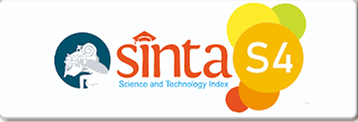PARENTS’ COMMUNICATION PATTERNS TOWARDS CHILDREN WITH MENTAL DISORDERS
Abstract
Communication is a necessity or means of social interaction for human life. However, some individuals, such as mentally retarded children, experience difficulties in communicating due to various factors and environments. This study aims to understand the communication patterns used by parents in interacting with children who suffer from mental retardation. The method used is Systematic Literature Review to explore insights into parents' communication patterns towards mentally retarded children. The researcher collected, summarized, evaluated, interpreted and synthesized information from journals published between 2019-2024. The results showed that communication patterns used by parents can affect learning outcomes and behavioral changes in children with mental retardation. The ideal communication pattern is interpersonal communication that involves direct interaction and feedback between parents and children. Parents need to have extra patience in communicating with mentally retarded children, and communication must be done regularly so that communication development for children can run well. Based on the author's understanding, interpretation and evaluation of various existing journals, it turns out that the communication pattern most favored by mentally retarded children is through audio and video-based multimedia interactive media and gross and fine motor skills through the puzzle game method.
Keywords
Full Text:
PDFReferences
Cuypers, M., Koks-Leensen, M. C. J., Schalk, B. W. M., Bakker-van Gijssel, E. J., Leusink, G. L., & Naaldenberg, J. (2023). All-cause and cause-specific mortality among people with and without intellectual disabilities during the COVID-19 pandemic in the Netherlands: a population-based cohort study. The Lancet Public Health, 8(5), e356–e363. https://doi.org/10.1016/S2468-2667(23)00062-2
Hidayat, A. L. (2021). Peran Komunikasi Keluarga dalam Kemandirian Anak Berkebutuhan Khusus Tuna Grahita di Yayasan Rumah Bersama. MEDIALOG: Jurnal Ilmu Komunikasi, 4(1), 110–121. https://doi.org/10.35326/medialog.v4i1.1010
Maulidiyah, F. N. (2020). Media Pembelajaran Multimedia Interaktif Untuk Anak Tunagrahita Ringan. Jurnal Pendidikan, 29(2), 93–100. https://doi.org/10.32585/jp.v29i2.647
Muzakkir, Samwil, Fadhlain, S., & Sempena, I. D. (2022). Proses Sosial dan Fenomena Retardasi Mental di Kabupaten Aceh Barat. Jurnal Sosiologi Agama Indonesia (JSAI), 3(3), 186–200. https://doi.org/10.22373/jsai.v3i3.2107
Noach, Y. M. C., Noach, G. M. C., & Amseke, F. V. (2021). Pola Komunikasi Orang Tua Terhadap Anak Autis Di Kelurahan Oebufu Universitas Nusa Cendana Kupang 2. Ra’ah Journal of Pasoral Counseling Available Online At, 1(2), 71–82. http://ejournal.staknkupang.ac.id/ojs/index.php/rah
Nurharyani, O. P., & Nugroho, B. A. P. (2020). The Language Acquisition of a Child With Mental Retardation (a Psycholinguistic Study). Jurnal Lingua Idea, 11(2), 92. https://doi.org/10.20884/1.jli.2020.11.2.2452
Retnosari, I. E., & Pujiastuti, R. (2021). Maksim Kuantitas dan Maksim Kualitas dalam Tuturan Bahasa Indonesia pada Anak Disabilitas Intelektual. Ranah: Jurnal Kajian Bahasa, 10(2), 270. https://doi.org/10.26499/rnh.v10i2.4053
Wagenaar, M. C., van der Putten, A. A. J., Douma, J. G., van der Schans, C. P., & Waninge, A. (2022). Definitions, signs, and symptoms of constipation in people with severe or profound intellectual disabilities: A systematic review. Heliyon, 8(5), e09479. https://doi.org/10.1016/j.heliyon.2022.e09479
Wardana, K. E. L., Suarmini, K. A., Sugiartini, D. K., & Wahyuni, N. K. E. (2019). Terapi Bermain bagi Tuna Grahita di SLB Negeri 2 Singaraja Bali. Jurnal Peduli Masyarakat, 2(2), 65–72. https://doi.org/10.37287/jpm.v2i2.112
Yanuar, D., Aznam, Z., & Retnaningsih, E. T. (2019). Komunikasi Antar Pribadi Ibu Tunggal dan Anak Penyandang Disabilitas. Inklusi, 1, 269–290.
Yogantari, L. P. W., Yoenanto, N. H., & Marhaeni, A. (2023). Meningkatkan Kemampuan Membaca Permulaan Melalui Metode Mnemonik dan Orton-Gillingham pada Anak dengan Disabilitas Intelektual. Jurnal Diversita, 9(2), 167–175. https://doi.org/10.31289/diversita.v9i2.8225
Yuliana, E., Siregar, I. K., & Saputra, E. (2022). Sistem Pakar Untuk Diagnosa Retardasi Mental Anak dengan Metode Bayes Berbasis Web. Building of Informatics, Technology and Science (BITS), 4(2), 474–482. https://doi.org/10.47065/bits.v4i2.2038
Zaindra, W. O. R. (2023). Pola Komunikasi Ibu dan Anak Disabilitas di Kecamatan Talaga Raya Kabupaten Buton Tengah. Jurnal Ilmu Komunikasi Dan Sosial, 1(3), 253–262. https://journal.widyakarya.ac.id/index.php/harmoni-widyakarya/article/view/1276%0Ahttps://journal.widyakarya.ac.id/index.php/harmoni-widyakarya/article/download/1276/1323
DOI: https://doi.org/10.29103/jsds.v10i2.17256
 Article Metrics
Article Metrics
 Abstract Views : 146 times
Abstract Views : 146 times
Refbacks
- There are currently no refbacks.
Copyright (c) 2024 Jurnal Sosiologi Dialektika Sosial

This work is licensed under a Creative Commons Attribution-NonCommercial-ShareAlike 4.0 International License.
Diterbitkan Oleh: Program Studi Sosiologi, Fakultas Ilmu Sosial dan Ilmu Politik Universitas Malikussaleh
REDAKSI JURNAL SOSIOLOGI DIALEKTIKA SOSIAL
Gedung Program Studi Sosiologi, Fakultas Ilmu Sosial dan Ilmu Politik Universitas Malikussaleh. Kampus Bukit Indah, Jln. Sumatera No.8, Kec. Muara Satu Kota Lhokseumawe, Prov. Aceh, Indonesia.
Email: jurnalsosiologi@unimal.ac.id

This work is licensed under a Creative Commons Attribution-NonCommercial-ShareAlike 4.0 International License









.png)




